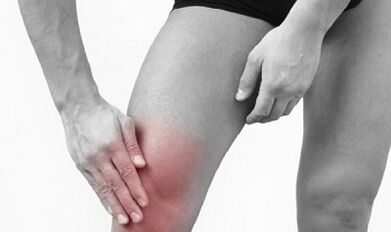
One of the most common pathologies in the musculoskeletal system is the arthrosis of the knee joint (if not gonartrosis) is a chronic disease, accompanied by dysfunction and destruction of the articular structure of the knee.
The results of the destruction process are sharp restrictions or loss of joint mobility, and as a result - a decrease in performance, defects.
It is possible to avoid adverse effects only if you are diagnosed early and therapy on time.
Cause
In the original, knee arthrosis is primary and secondary.The main develops as a free disease, more often diagnosed in older people, and in this case it is due to age -related changes in the tissue.Secondary gonarthrosis is the result of diseases and other disorders in the body.
The development of gonarthrosis contributes to:
- injury (dislocation, bone fracture, meniscus damage);
- Disease of the musculoskeletal system (congenital deformation of the foot, knee displacement, chondrocalcinosis, arthritis, osteoporosis);
- Continuous high load of joints due to professional activities, professional sports;
- overweight, obesity;
- Endocrine disease, including diabetes, hypothyroidism, acromigaly;
- metabolic disorders;
- Genetic predisposition.
Symptom
Inflammation with knee joint arthrosis is accompanied by two main clinical manifestations - pain and edema.The intensity and frequency of the appearance of the pain depend on the depth of the damage to the joint structure.In the early stages, the pain was only felt by the load, quickly resting.With advanced gonarthrosis, pain is always present, increasing during movement, with weather changes.
Signs -Other Arthrosis Signs of Knee together:
- Crunch while moving;
- stiffness in joints, violations of motor function;
- Knee deformation (with neglected gonarthrosis).
Gonarthrosis can be accompanied by synovitis (fluid accumulation in the joint cavity) and the formation of baker cyst (elastic formation behind the knee).
The degree of arthrosis
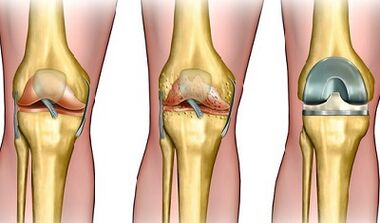
Symptoms of knee joint arthrosis vary depending on the depth of damage to the knee structure, and therefore 3 stages of pathology are distinguished.
- 1 degree knee arthrosis of 1 degreeIt is characterized by poor pain at the load (at a time of rest), with a little stiffness after sleep.In radiographic images, narrowing of non -essential joint gaps (less than one -third), the presence of single osteophytes (growing bone) is observed.
- 2 -degree joint knee arthrosisIt is accompanied by pain and characteristic crisis during movement.The pain persists for some time resting.Morning stiffness, amplitude restrictions of movement are observed.The diagnostic procedure reveals the narrowing of the joint gap (more than half) and various osteophytes.
- 3 -degree knee arthrosisIt is accompanied by persistent pain, which, during movement and at night, increases.Morning stiffness lasts longer than one hour with the disadvantage of inflammation and at least half an hour - during the pardon.Joint mobility is limited or completely lost.In radiographic images, a variety of large osteophytes, cysts can be seen.The joint gap is narrowed by more than two people from the norm.
Depending on the level of knee joint arthrosis, the patient is prescribed conservative or surgical treatment.
Diagnostics
Diagnosis of knee joint arthrosis includes visual examination, patient complaint analysis, laboratory tests (urine analysis, general and biochemical blood tests) and instrumental examination methods.
The following diagnostic procedures allow you to confirm or deny the diagnosis:
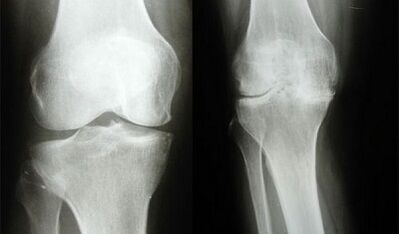
- Radiography;
- Ultrasound (ultrasound);
- MRI (magnetic resonance imaging);
- CT (computed tomography);
- Arthroscopy and scintigraphy (with tumor suspicion).
Using this method, it is possible to detect the narrowing of the joint gap, the level of thinning and deformation of the cartilage, the presence of fluid in the joint cavity, structural changes in the synovial membrane, the growth of osteofitis and the focus of the cartilage ossification.
Conservative treatment
Conservative treatment methods can reduce pain and inflammation, improve blood circulation and nutrition of perasantate tissue, strengthen the muscle.
For this purpose, they are held:
- drug therapy;
- restrictions;
- physiotherapy and manual therapy;
- Physical Education Medicine.
An important component of the treatment of arthrosis is the compliance of the therapeutic diet.
Conservative treatment of knee joint arthrosis will be effective in the early stages of the disease, when small dystrophic cartridge cartilage, inflammation and impaired synovial shell is observed.
Drug
Drug treatment includes appointment:
- not anti -inflammation (NSAIDs);
- Chondroprotectors;
- hyaluronic acid.
Nsaid
Anti -Anti -Anti -Medicine Medicines Helps relieve inflammation, reduce its main symptoms -edema and pain.
Preparations are set in the form of solutions (for intramuscular administration) or tablets, capsules (for oral administration).Capsules and tablets of NSAID knee joint arthrosis are taken in short courses, as medicines have a strong irritating effect on gastric mucosa and can cause peptic ulcer development, has many other side effects.
In addition, the prescribed external medicines (ointment, gel, cream) are based on anti -non -–steroid components.Local therapy is allowed to run for longer.
NSAIDs have significant anti -inflammatory effects, but with prolonged use contributes to the destruction of cartilage.
NSAIDs is a symptom therapy.They help eliminate the symptoms of unpleasant diseases, but do not affect the condition of the cartilage.In contrast to this product, chondroprotectors and hyaluronic acid accelerate the process of regeneration of cartilage and slow down its destruction.
Chondroprotectors
The chondroprotectors group drugs contain chondroitin and glucosamine (elements of cartilage structure) and help restore the knee with knee joint arthrosis.They are available in tablets, powder for oral administration, solutions for injection.
The minimum course taking tablets and powders is 3 months.After the break, the course is repeated 2-3 times.The course of treatment with a solution includes 12-15 injections, repeated 2-3 times a year.
The first positive result of treatment with chondroprotectors can only be seen a few months after the onset of therapy.
Hyaluronic acid
Hyaluronic acid is introduced injected into the affected joints.Healing for knee joint arthrosis performs lubrication roles - surrounding the articular surface, thus reducing friction between them.
Therapy with hyaluronic acid helps to improve the elasticity of cartilage, preventing the destruction of the articular structure, which increases joint mobility, reduced inflammation symptoms.Medications are well received, do not cause side effects.One of their weaknesses is the high cost.
Courses of treatment with hyaluronic acid usually include 3-4 injections, which are performed by 10-14 days.
Sanction

If with an anti -SSTEROID anti -inflammation drug, it is not possible to relieve knee pain with arthrosis, restrictions are performed -treatment methods in which medications are injected directly into the affected tissue to relieve pain and inflammation.In arthrosis therapy, articular injection (injection in the articular cavity) and periarticular blockade (into the periartic cavity) are used.
The main advantage of this method is the immediate purpose of the purpose, because with such an introduction, the maximum concentration of the active ingredient is made in the inflammation zone.In addition, medicines do not fall into the systemic blood flow, which significantly reduce the risk of adverse reactions.
In later stages gonartrosis, narrow articular gaps, growing osteophytes, defective joint surfaces, therefore, only peryrian restrictions are allowed.
Knee joint restrictions for arthrosis can be performed using anesthetic and corticosteroids.
Anesthetics are usually introduced in combination with steroid hormones to reduce the pain of the procedure.
Hyaluronic acid and chondroprotectors can also be introduced directly into the joints.But in this case, we do not talk about restrictions, but about intra -Articular injection, as these drugs do not prevent pain impulses, but trigger the process of regenerating cartilage tissue.
Physiotherapy and manual therapy
The main methods of physiotherapy effects used in the treatment of arthrosis include:
- laser treatment;
- ultrasound therapy;
- Cryotherapy;
- therapy with paraffin and ozokerite;
- Mud.
The main task of all physiotherapy procedures is to stimulate blood circulation in nearby tissues, improving cartilage nutrition.
Exercise therapy
The pain syndrome forces patients with gonartrosis to limit motor activity, as a result of the nearby ligaments and muscle atrophy.This condition negatively affects the joint tissue, as during the movement of nutrients penetrates the synovial fluid into the cartilage.If the joints are constantly resting, the dystrophic process is aggravated.
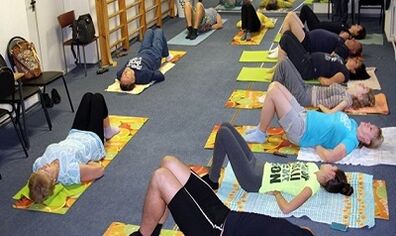
That is why physiotherapy training is a component of conservative therapy integral.Moderate physical activity allows you to strengthen your muscles, improve the strength of the articular structure, eliminate stiffness and improve the function of the knee motor.
Therapeutic training exercises are developed by the doctor individually for each patient, taking into account the depth of the lesion and the functioning of the articular structure.
A general proposal to conduct training therapy for knee joint arthrosis:
- Start class only after stopping the signs of acute inflammation;
- Do all the exercises smoothly, without sudden movement;
- The load increases gradually;
- eliminating high load on joints (enhanced/extended knee);
- If pain or discomfort arises, stop the exercise.
Diet
With gonarthrosis, the product containing: contains:
- amino acids (dairy products, low meat types);
- collagen (dish with gelatin);
- non -replaced fatty acids (vegetable oils, fish);
- Sulfur and selenium (legumes, cereals, cabbage and apples, beef, chicken, eggs).
It's also important:
- eliminating the use of smoked meat, pickles, fireplace;
- Limit the use of salt;
- adhere to a 5 -fold diet;
- Note to drink mode.
Excessive weight is one of the main factors that cause the development of knee joint arthrosis.Therefore, the job of overweight patients is weight loss.In this case, you can reach the decision only with the help of a diet, as intensive sports are harmful to the inflamed joints.
To lose weight, it is advisable to exclude from the menu:
- type of fat and fish fat;
- cream, homemade sour cream and other dairy products with a high percentage of fat content;
- margarine, mayonnaise, various sauces;
- Confectionery;
- fast food;
- Sweet drinks.
Surgical
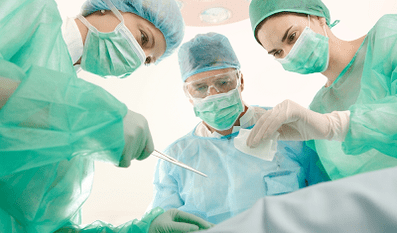
Knee joint arthrosis of the 3rd degree is not acceptable to conservative therapy, so surgery is the only way out for patients.
There are two options for surgical intervention:
- Correction osteotomy- carried out in the early stages of the 3rd stage development of gonarthrosis, if the cartilage is partially destroyed, it is possible to eliminate osteophytes;
- Endoprosthetics- Joint replacement or destroyed part is done with complete destruction of cartilage.
Prophesy
Pathological changes in the joint structure are progressive, irreversible.However, with the right diagnosis and proper treatment, you can stop inflammation and stop dystrophic changes in cartilage - knee joint arthrosis in the first stage is to lend itself to conservative therapy.
With the 2nd degree arthrosis, accompanied by cartilage destruction and the formation of osteophytes, conservative methods allow you to slow down or suspend cartilage deformation, stop inflammation and increase motor activity.However, doctors often have to use restrictions, arthroscopy.
It is not possible to cure 3 -degree knee joint arthrosis in a conservative way.The only way to restore knee movement is surgical intervention.

























